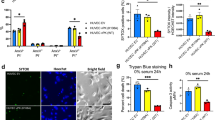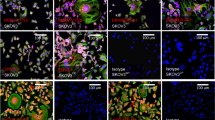Abstract
Primary effusion lymphomas (PELs) are aggressive Kaposi's sarcoma herpesvirus (KSHV)-induced malignancies with median survival time <6 months post-diagnosis. Mutations in the TP53 gene seldom occur in PELs, suggesting that genetic alterations in the TP53 are not selected during PEL progression. We have reported that p53 reactivation by an inhibitor of the p53–MDM2 interaction, Nutlin-3, induces selective and massive apoptosis in PEL cells leading to efficient anti-tumor activity in a subcutaneous xenograft model for PEL. Here, we show compelling anti-tumor activity of Nutlin-3 in the majority of intraperitoneal PEL xenografts in vivo. Interestingly, our results demonstrate that spontaneous induction of viral lytic replication in tumors could drastically attenuate the p53-dependent apoptotic response to Nutlin-3. Moreover, viral reactivation compromised p53-dependent apoptosis in PEL cells treated with genotoxic anti-cancer agents doxorubicin and etoposide. We have recently demonstrated that the Ser/Thr kinases Pim 1 and 3 are required to trigger induction of the lytic replication cascade of KSHV. We have now assessed the ability of a novel Pim kinase inhibitor to restore the Nutlin-3-induced cytotoxicity in lytic PEL cells. PEL cells induced to lytic replication by phorbol esters showed 50% inhibition of active viral replication following treatment with the Pim kinase inhibitor. Importantly, co-treatment of these cells with the kinase inhibitor and Nutlin-3 resulted in a robust restoration of the Nutlin-3-induced cell death. These results highlight the potential impact of activation of viral lytic replication on disease progression and response to treatment in KSHV-induced lymphomas.
This is a preview of subscription content, access via your institution
Access options
Subscribe to this journal
Receive 50 print issues and online access
$259.00 per year
only $5.18 per issue
Buy this article
- Purchase on Springer Link
- Instant access to full article PDF
Prices may be subject to local taxes which are calculated during checkout




Similar content being viewed by others
References
Ablashi DV, Chatlynne LG, Whitman Jr JE, Cesarman E . Spectrum of Kaposi's sarcoma-associated herpesvirus, or human herpesvirus 8, diseases. Clin Microbiol Rev 2002; 15: 439–464.
Nador RG, Cesarman E, Chadburn A, Dawson DB, Ansari MQ, Sald J et al. Primary effusion lymphoma: a distinct clinicopathologic entity associated with the Kaposi's sarcoma-associated herpes virus. Blood 1996; 88: 645–656.
Cesarman E, Nador RG, Aozasa K, Delsol G, Said JW, Knowles DM . Kaposi's sarcoma-associated herpesvirus in non-AIDS related lymphomas occurring in body cavities. Am J Pathol 1996; 149: 53–57.
Cesarman E, Chang Y, Moore PS, Said JW, Knowles DM . Kaposi's sarcoma-associated herpesvirus-like DNA sequences in AIDS-related body-cavity-based lymphomas. N Engl J Med 1995; 332: 1186–1191.
Casper C . New approaches to the treatment of human herpesvirus 8-associated disease. Rev Med Virol 2008; 18: 321–329.
Boulanger E, Gerard L, Gabarre J, Molina JM, Rapp C, Abino JF et al. Prognostic factors and outcome of human herpesvirus 8-associated primary effusion lymphoma in patients with AIDS. J Clin Oncol 2005; 23: 4372–4380.
Hollstein M, Sidransky D, Vogelstein B, Harris CC . p53 mutations in human cancers. Science 1991; 253: 49–53.
Kubbutat MH, Jones SN, Vousden KH . Regulation of p53 stability by Mdm2. Nature 1997; 387: 299–303.
Leach FS, Tokino T, Meltzer P, Burrell M, Oliner JD, Smith S et al. p53 Mutation and MDM2 amplification in human soft tissue sarcomas. Cancer Res 1993; 53: 2231–2234.
Vassilev LT, Vu BT, Graves B, Carvajal D, Podlaski F, Filipovic Z et al. In vivo activation of the p53 pathway by small-molecule antagonists of MDM2. Science 2004; 303: 844–848.
Tovar C, Rosinski J, Filipovic Z, Higgins B, Kolinsky K, Hilton H et al. Small-molecule MDM2 antagonists reveal aberrant p53 signaling in cancer: implications for therapy. Proc Natl Acad Sci USA 2006; 103: 1888–1893.
Kojima K, Konopleva M, Samudio IJ, Shikami M, Cabreira-Hansen M, McQueen T et al. MDM2 antagonists induce p53-dependent apoptosis in AML: implications for leukemia therapy. Blood 2005; 106: 3150–3159.
Stuhmer T, Chatterjee M, Hildebrandt M, Herrmann P, Gollasch H, Gerecke C et al. Nongenotoxic activation of the p53 pathway as a therapeutic strategy for multiple myeloma. Blood 2005; 106: 3609–3617.
Carbone A, Cilia AM, Gloghini A, Capello D, Todesco M, Quattrone S et al. Establishment and characterization of EBV-positive and EBV-negative primary effusion lymphoma cell lines harbouring human herpesvirus type-8. Br J Haematol 1998; 102: 1081–1089.
Sarek G, Kurki S, Enback J, Iotzova G, Haas J, Laakkonen P et al. Reactivation of the p53 pathway as a treatment modality for KSHV-induced lymphomas. J Clin Invest 2007; 117: 1019–1028.
Keller SA, Hernandez-Hopkins D, Vider J, Ponomarev V, Hyjek E, Schattner EJ et al. NF-kappaB is essential for the progression of KSHV- and EBV-infected lymphomas in vivo. Blood 2006; 107: 3295–3302.
Sun R, Lin SF, Gradoville L, Yuan Y, Zhu F, Miller G . A viral gene that activates lytic cycle expression of Kaposi's sarcoma-associated herpesvirus. Proc Natl Acad Sci USA 1998; 95: 10866–10871.
Chandran B, Bloomer C, Chan SR, Zhu L, Goldstein E, Horvat R . Human herpesvirus-8 ORF K8.1 gene encodes immunogenic glycoproteins generated by spliced transcripts. Virology 1998; 249: 140–149.
Keller SA, Schattner EJ, Cesarman E . Inhibition of NF-kappaB induces apoptosis of KSHV-infected primary effusion lymphoma cells. Blood 2000; 96: 2537–2542.
Grossmann C, Ganem D . Effects of NFkappaB activation on KSHV latency and lytic reactivation are complex and context-dependent. Virology 2008; 375: 94–102.
Scott ML, Fujita T, Liou HC, Nolan GP, Baltimore D . The p65 subunit of NF-kappa B regulates I kappa B by two distinct mechanisms. Genes Dev 1993; 7: 1266–1276.
Morotti A, Cilloni D, Pautasso M, Messa F, Arruga F, Defilippi I et al. NF-kB inhibition as a strategy to enhance etoposide-induced apoptosis in K562 cell line. Am J Hematol 2006; 81: 938–945.
Davis DA, Rinderknecht AS, Zoeteweij JP, Aoki Y, Read-Connole EL, Tosato G et al. Hypoxia induces lytic replication of Kaposi sarcoma-associated herpesvirus. Blood 2001; 97: 3244–3250.
Haque M, Davis DA, Wang V, Widmer I, Yarchoan R . Kaposi's sarcoma-associated herpesvirus (human herpesvirus 8) contains hypoxia response elements: relevance to lytic induction by hypoxia. J Virol 2003; 77: 6761–6768.
Loncaster JA, Harris AL, Davidson SE, Logue JP, Hunter RD, Wycoff CC et al. Carbonic anhydrase (CA IX) expression, a potential new intrinsic marker of hypoxia: correlations with tumor oxygen measurements and prognosis in locally advanced carcinoma of the cervix. Cancer Res 2001; 61: 6394–6399.
Boulanger E, Daniel MT, Agbalika F, Oksenhendler E . Combined chemotherapy including high-dose methotrexate in KSHV/HHV8-associated primary effusion lymphoma. Am J Hematol 2003; 73: 143–148.
Simonelli C, Spina M, Cinelli R, Talamini R, Tedeschi R, Gloghini A et al. Clinical features and outcome of primary effusion lymphoma in HIV-infected patients: a single-institution study. J Clin Oncol 2003; 21: 3948–3954.
Qin Z, Dai L, Bratoeva M, Slomiany MG, Toole BP, Parsons C . Cooperative roles for emmprin and LYVE-1 in the regulation of chemoresistance for primary effusion lymphoma. Leukemia 2011; 25: 1598–1609.
Wies E, Hahn AS, Schmidt K, Viebahn C, Rohland N, Lux A et al. The Kaposi's sarcoma-associated Herpesvirus-encoded vIRF-3 inhibits cellular IRF-5. J Biol Chem 2009; 284: 8525–8538.
Nakamura H, Lu M, Gwack Y, Souvlis J, Zeichner SL, Jung JU . Global changes in Kaposi's sarcoma-associated virus gene expression patterns following expression of a tetracycline-inducible Rta transactivator. J Virol 2003; 77: 4205–4220.
Petre CE, Sin SH, Dittmer DP . Functional p53 signaling in Kaposi's sarcoma-associated herpesvirus lymphomas: implications for therapy. J Virol 2007; 81: 1912–1922.
Kedes DH, Ganem D . Sensitivity of Kaposi's sarcoma-associated herpesvirus replication to antiviral drugs. Implications for potential therapy. J Clin Invest 1997; 99: 2082–2086.
Davis DA, Singer KE, Reynolds IP, Haque M, Yarchoan R . Hypoxia enhances the phosphorylation and cytotoxicity of ganciclovir and zidovudine in Kaposi's sarcoma-associated herpesvirus infected cells. Cancer Res 2007; 67: 7003–7010.
Matthews T, Boehme R . Antiviral activity and mechanism of action of ganciclovir. Rev Infect Dis 1988; 10 (Suppl 3): S490–S494.
Lalezari JP, Stagg RJ, Jaffe HS, Hitchcock MJ, Drew WL . A preclinical and clinical overview of the nucleotide-based antiviral agent cidofovir (HPMPC). Adv Exp Med Biol 1996; 394: 105–115.
Nicholas J . Human gammaherpesvirus cytokines and chemokine receptors. J Interferon Cytokine Res 2005; 25: 373–383.
Varjosalo M, Bjorklund M, Cheng F, Syvanen H, Kivioja T, Kilpinen S et al. Application of active and kinase-deficient kinome collection for identification of kinases regulating hedgehog signaling. Cell 2008; 133: 537–548.
Cheng F, Weidner-Glunde M, Varjosalo M, Rainio EM, Lehtonen A, Schulz TF et al. KSHV reactivation from latency requires Pim-1 and Pim-3 kinases to inactivate the latency-associated nuclear antigen LANA. PLoS Pathog 2009; 5: e1000324.
Akue-Gedu R, Rossignol E, Azzaro S, Knapp S, Filippakopoulos P, Bullock AN et al. Synthesis, kinase inhibitory potencies, and in vitro antiproliferative evaluation of new Pim kinase inhibitors. J Med Chem 2009; 52: 6369–6381.
Santio NM, Vahakoski RL, Rainio EM, Sandholm JA, Virtanen SS, Prudhomme M et al. Pim-selective inhibitor DHPCC-9 reveals Pim kinases as potent stimulators of cancer cell migration and invasion. Mol Cancer 2010; 9: 279.
Brown HJ, McBride WH, Zack JA, Sun R . Prostratin and bortezomib are novel inducers of latent Kaposi's sarcoma-associated herpesvirus. Antivir Ther 2005; 10: 745–751.
Dittmer DP . Transcription profile of Kaposi's sarcoma-associated herpesvirus in primary Kaposi's sarcoma lesions as determined by real-time PCR arrays. Cancer Res 2003; 63: 2010–2015.
Ganem D . KSHV infection and the pathogenesis of Kaposi's sarcoma. Annu Rev Pathol 2006; 1: 273–296.
Crum-Cianflone NF, Wallace MR, Looney D . Successful secondary prophylaxis for primary effusion lymphoma with human herpesvirus 8 therapy. Aids 2006; 20: 1567–1569.
Hocqueloux L, Agbalika F, Oksenhendler E, Molina JM . Long-term remission of an AIDS-related primary effusion lymphoma with antiviral therapy. Aids 2001; 15: 280–282.
Luppi M, Trovato R, Barozzi P, Vallisa D, Rossi G, Re A et al. Treatment of herpesvirus associated primary effusion lymphoma with intracavity cidofovir. Leukemia 2005; 19: 473–476.
Katano H, Sato Y, Kurata T, Mori S, Sata T . Expression and localization of human herpesvirus 8-encoded proteins in primary effusion lymphoma, Kaposi's sarcoma, and multicentric Castleman's disease. Virology 2000; 269: 335–344.
Sarek G, Jarviluoma A, Ojala PM . KSHV viral cyclin inactivates p27KIP1 through Ser10 and Thr187 phosphorylation in proliferating primary effusion lymphomas. Blood 2006; 107: 725–732.
Acknowledgements
We thank M Laiho for reagents, discussions and critical review of this manuscript; C Boshoff for valuable comments; E Cesarman for providing the BC-3/NF-κB-luc cell line; D Ganem for anti-RTA antibody; and B Chandran for anti-ORF59 and anti-LANA antibodies. J Bärlund, S Vartia and P Kivinen are acknowledged for excellent technical assistance. This work was supported by grants from the Academy of Finland (PMO, PL), Finnish Cancer Foundations (PMO, PL), Sigrid Juselius Foundation (PMO), University of Helsinki Foundations (PMO), and from the European Union (FP6 INCA project LSHC-CT-2005-018704) to PMO, AJ, GS and LM were supported by the University of Helsinki Graduate Program in Biotechnology and Molecular Biology. JE was supported by the Helsinki Biomedical Graduate School. GS was also supported by Finnish Cultural Foundation, Paulo Foundation, K Albin Johansson Foundation, Maud Kuistila Memorial Foundation, University of Helsinki Funds and Biomedicum Helsinki Foundation.
Author information
Authors and Affiliations
Corresponding authors
Ethics declarations
Competing interests
The authors declare no conflict of interest.
Additional information
Supplementary Information accompanies the paper on the Oncogene website
Supplementary information
Rights and permissions
About this article
Cite this article
Sarek, G., Ma, L., Enbäck, J. et al. Kaposi's sarcoma herpesvirus lytic replication compromises apoptotic response to p53 reactivation in virus-induced lymphomas. Oncogene 32, 1091–1098 (2013). https://doi.org/10.1038/onc.2012.118
Received:
Revised:
Accepted:
Published:
Issue Date:
DOI: https://doi.org/10.1038/onc.2012.118
Keywords
This article is cited by
-
Nm23-H1 induces apoptosis in primary effusion lymphoma cells via inhibition of NF-κB signaling through interaction with oncogenic latent protein vFLIP K13 of Kaposi’s sarcoma-associated herpes virus
Cellular Oncology (2022)
-
Ribonucleotide reductase represents a novel therapeutic target in primary effusion lymphoma
Oncogene (2017)
-
Multi-targeted therapy of everolimus in Kaposi’s sarcoma associated herpes virus infected primary effusion lymphoma
Apoptosis (2017)
-
The regulatory role of protein phosphorylation in human gammaherpesvirus associated cancers
Virologica Sinica (2017)
-
Structural proteins of Kaposi’s sarcoma-associated herpesvirus antagonize p53-mediated apoptosis
Oncogene (2015)



